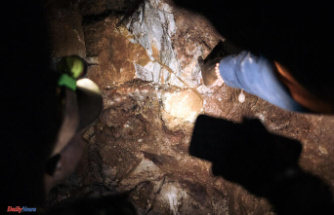Who doesn't appreciate the shadow that an open book casts on the head when you finally find time to read in a meadow or on the beach on vacation. Here are the editors' tips for new releases from Hamburg and the surrounding area.
Anyone who knows the novels by Heinz Strunk suspects that the title of his latest work does not mean harmless summer reading on the beach - even if Strunk's hero, a doctorate in commercial law between two highly paid jobs, is looking for this for three months in the Baltic Sea resort of Niendorf . Instead of finding relaxation, he gets caught up in a coke-rum morass between concrete buildings, mediocre fish sandwiches and cycling pensioners and in the end capitulates to himself.
As a precise observer and merciless describer, Strunk portrays the fall of an arrogant, self-satisfied achiever, unmasking his misogynistic and misanthropic hero in his ridiculousness and yet full of mild empathy. With his usual pointedness, he tells of the strangeness and repulsion of the people the lawyer meets and once again reveals his hero's self-rejection – a grandiose description of an inner and outer sadness that can be excellently examined on site this summer. Ultimately, a beach reading after all. British
Hein Stunk: A summer in Niendorf. Rowohlt Verlag, 240 pages, 22 euros.
In a mammoth project, Christine Lendt and Michael Zapf drained all of Hamburg's rivers and streams and documented them in the book "Hamburg Flows...". The author and the photographer came to 85 bodies of water. A large part are smaller tributaries and streams that feed the Elbe, Alster, Bille and Wandse. On 240 pages, the two take their readers with them on numerous hikes and walks all over the Hanseatic city, from the source to the mouth of a body of water. In addition to well-known ones, such as the Alster hiking trail or routes on the Elbe beach, there are hidden routes to be discovered, such as the path along the eight-kilometer Kollau in the Niendorf enclosure. All tours, whether short or long, have in common that they are described very precisely and also provide information about special things along the way, places to stop for refreshments and places of cultural interest. JU
Christine Lendt and Michael Zapf: Hamburg is flowing... Ellert and Richter Verlag, 240 pages, 18 euros.
The Hamburg Wadden Sea National Park with three islands has also been part of the UNESCO World Heritage List since 2011. While Nigehern may not be entered, Scharhörn is particularly interesting for bird lovers and Neuwerk even attracts 120,000 guests a year. In his book "Hamburg's Islands and Beaches", Edgar Hasse explains why excursions to these and 38 other destinations on and in Hamburg's waters are worthwhile. In the well-structured, clear volume there is a map for each destination, the author describes interesting facts about fauna, flora and special features in addition to how to get there. Places on the water include Billerhuder Insel, an accessible allotment island with around 600 allotments. If you like, you can swim around it or go on a paddle tour. The descriptions of Kaltehofe, Neuhof, Steinwerder, Krautsand, Cremon, Eichbaumsee, Neuländer See or Garrensee also awaken wanderlust. JU
Edgar Hasse: Hamburg's islands and beaches, Junius Verlag, 184 pages, 16.80 euros.
With the historical anthology "The Memorial", the journalist Michael Legband presents (his) opus magnum. On 416 pages, the author and other experts not only tell the story of the first memorial for the victims of National Socialism in Northern Europe in detail, exciting - because personally committed - and outstandingly documented. But with it, as an example, the history of how the Germans dealt with the Nazi era - up until today, including all the dark and bright sides.
The memorial, initiated and largely financed by Holocaust survivor and film producer Gyula Trebitsch (1914-2005) and private supporters, was erected in Itzehoe in 1946. After the war, 44 liberated Jews lived in the city with around 30,000 inhabitants. The architect of the place of remembrance with inscriptions by German poets was the leading master builder of North German Brick Expressionism, Fritz Höger (1877-1949). stg
Michael Legband: The memorial, Ludwig Verlag, 416 pages, 34.90 euros.
It begins in a "Rehaloch", in "Rollator-City", the brilliant debut of the Hamburg author Claudia Schumacher. Juli is 17, mentally broken and violent, one of four children of a respected family of lawyers in the suburbs of Stuttgart. The father beats and humiliates, the mother keeps up appearances. It is the story of a completely dysfunctional family full of mental and physical cruelty.
Schumacher tells them in three sections. Because at the age of 20, Juli escaped from domestic horror and went to Berlin, did a doctorate in mathematics, became a professional gamer and called himself Jules from then on. But she cannot shake off her past. Not even years later, when she becomes Julia at the side of a boring man and her mother's decal. Schumacher portrayed the young woman in a powerfully eloquent way, each part in its own sound adapted to her age and life situation. The tempo creates a pull that is difficult to resist. British
Claudia Schumacher, love is powerful, dtv publishing company, 372 pages, 22 euros.
The Hamburg author Ildikó von Kürthy has already presented a number of humorous, clever women's novels full of neurotic heroines. She started with "Moonlight Tariff" more than 20 years ago. Like herself, Kürthy's heroines have now grown older. In her latest novel, the life of her protagonist, Ruth, turns completely upside down on her 50th birthday. Her husband's affair is just the icing on the cake.
For more than 15 years, her television commissioner husband deceived her in the most perfidious way and created a construct of lies that deprived Ruth of her dearest people and greatest desires. Kürthy has a precise eye for situations and sensitivities and an outstanding talent for describing them openly with dry wit. All of her characters prepare for a liberation. This is told in the usual entertaining manner and at the same time reveals with unusual seriousness the setbacks that come over the course of life or that gain in importance with advancing age. British
Ildikó von Kürthy, Tomorrow can come, Rowohlt Wunderlich Verlag, 368 pages, 22 euros.












